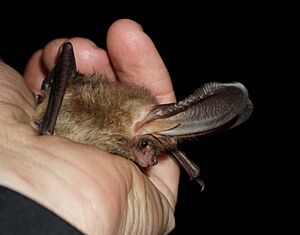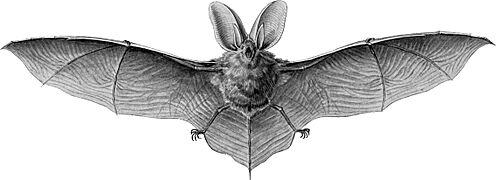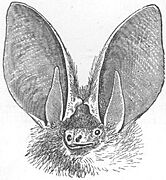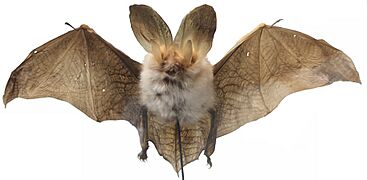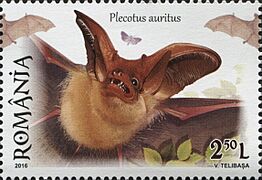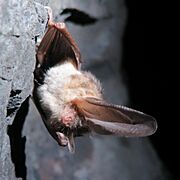Brown long-eared bat facts for kids
Quick facts for kids Brown long-eared bat |
|
|---|---|
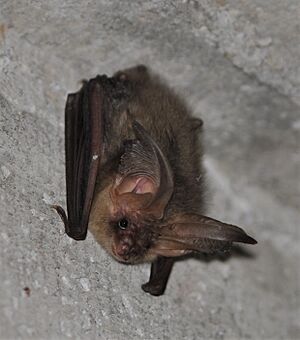 |
|
| Conservation status | |
| Scientific classification | |
 |
|
| Synonyms | |
|
Vespertilio auritus Linnaeus, 1758 |
The brown long-eared bat is a small bat found across Europe and Asia. It's also known as the common long-eared bat. These bats are easy to spot because of their super long ears! Their ears are about 3 to 4 centimeters long, which is almost as long as their body.
Brown long-eared bats are insectivores, meaning they eat insects. They look a lot like the rarer grey long-eared bat. Adult brown long-eared bats are quite small. Their body is about 4.5 to 4.8 centimeters long. They also have a tail that is about 4.1 to 4.6 centimeters long. These bats fly slower than many other bat species.
Contents
Where Do Brown Long-Eared Bats Live?
Brown long-eared bats live in many parts of Europe. You can find them almost everywhere except Greece, southern Italy, and southern Spain. Their home range extends east towards the Ural Mountains and the Caucasus region.
These bats often make their homes in buildings. They like quiet spaces in roofs, especially in cracks or around chimneys. They also live in tree holes and special bat boxes. Sometimes, they even use caves, which are very important places for them to sleep during winter. Their tree roosts can sometimes be close to the ground. Brown long-eared bats usually leave their roosts about an hour after the sun sets, when it's completely dark.
What Do Brown Long-Eared Bats Eat?
Brown long-eared bats hunt for food above woodland areas. They mostly eat moths. But their diet also includes other insects like earwigs, flies, and beetles. They often pick these insects off leaves and tree bark.
Unlike many other bats, they probably use their large eyes and ears to find prey. They don't rely on echolocation for hunting. Scientists have found that these bats can see their prey. They also use their excellent hearing to find insects. This helps them hunt in places where there are many trees and obstacles.
How Do Brown Long-Eared Bats Hunt?
Brown long-eared bats have a special way of hunting. They don't use echolocation to find their prey, which is unusual for bats. Echolocation is like using sound waves to "see" things. Instead, they use their amazing hearing. Their ears are so sensitive they can hear a moth flying!
This unique hunting method developed because some moths learned to hear bat echolocation. When moths heard the bat's sounds, they would try to escape. So, brown long-eared bats evolved to hunt silently, by just listening for their prey. They still use echolocation for navigating, but not for finding food. The sounds they use for echolocation are very high-pitched, between 27 and 56 kilohertz.
Gallery
-
Exemplar in the Oxford University Museum of Natural History



